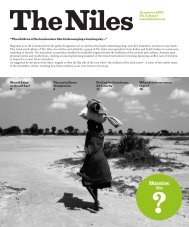A boat cannot go forward if each rows his own way
Be it to improve irrigation, manage floods and droughts or generate energy; dams have played a significant role in humanity’s progress. But the dam-building development model also has its flaws. The Niles journalists tackle the sensitive dam topic and self-aware that they all are in the same boat, they agree that it is time to start rowing the same way.
Be it to improve irrigation, manage floods and droughts or generate energy; dams have played a significant role in humanity’s progress. But the dam-building development model also has its flaws. The Niles journalists tackle the sensitive dam topic and self-aware that they all are in the same boat, they agree that it is time to start rowing the same way.
You also want an ePaper? Increase the reach of your titles
YUMPU automatically turns print PDFs into web optimized ePapers that Google loves.
The cascade effect:
TN 5
sharing information,
knowledge and experience
MiCT The Niles |
Based on a presentation
by Michael Abebe
Berlin, Germany
The interdependency of dams in a river system demands coordinated operation, so all
dams have an optimal configuration that, in the interplay with all others, minimises risks
and maximises mutual benefits for all riparian states.
T
he flow of the Nile differs depending on the
seasons. Any particular area along the banks
of the Nile might therefore get too much
water, leading to floods, or too little, causing
droughts. This fluctuation between excess
and deficit is typical, with irregular periods
of balance in between.
The term ‘cascade dams’ refers to two or
more water storage dams situated along the
same river or in the same river basin. These
dams are coupled such that the operation of
one reservoir affects the function of the others.
Depending on how harmonised these operations
are, the overall impact can be either
positive or negative.
If the operators of each dam are aware
of the needs of the others, and if all operators
agree to work cooperatively, the overall
negative impact would decrease.
For a coordinated operation of cascade
dams to succeed, all dams must follow
some fundamental principles. These include
the need to access and share accurate data,
particularly relating to weather and hydrology
forecasting. Each dam must operate with
a view on maximising overall benefits for
the entire river basin. Sharing these increased
benefits between, and within countries, as
equitably as possible, is a must.
Additionally, it is vital to set up operating
procedures and the necessary legal and
institutional frameworks. Both the procedures
and the frameworks must also include a
degree of reasonable flexibility to allow future
operators to deal with unexpected and unforeseen
situations.
Finally, all stakeholders representing various
sectors affected by the operation of cascade
dams must be consulted regularly, and their
views and concerns must be addressed.
The case of the Blue Nile
Along the Blue Nile river, there are five
particular dams of interest to look at: The High
Aswan Dam in Egypt, the Merowe, Sennar
and Roseires dams in Sudan and the Grand
Ethiopian Renaissance Dam in Ethiopia.
Dams are used for diverse reasons such
as to produce hydropower, to supply water for
consumption and irrigation, to mitigate floods,
but also for navigation, fisheries and
recreation.
Conflict may arise when the operation
of one dam adversely impacts the purposes
of another. For example, to generate hydropower,
one dam might keep most of the water
coming in, therefore filling its reservoir. Less
water will then be available for subsequent
dams on the river.
It is important to note that the Nile’s water
is not evenly distributed amongst Nile Basin
countries, which leads to an unevenly distributed
potential to develop water resources.
According to the Nile Basin Initiative (NBI),
the projected water demand in the 20 years
from 2014 to 2034 will increase by 60 percent
in the Nile Basin.
Balancing needs and interests means that
the needs of each party must be acknowledged
as legitimate, and served in a sustainable,
equitable and efficient manner.
So what is stopping the Nile Basin countries
from enacting such cooperation agreements
based on balancing needs?
Cooperative operation of dams could
bring many opportunities, such as helping
to adapt to climate change by bridging
droughts and preventing flood damage,
in addition to providing hydropower for
the whole of the Eastern Nile region.
It is critical to capitalise on the hydrological
knowledge already existing and to
take advantage of the enabling environment
created through the continuous cooperation
between the Nile Basin Initiative and its
Eastern Nile Technical Regional Office (ENTRO).
This could help encourage countries to
jointly set up data exchange and consultation
mechanisms and common standard guidelines
and rules for dam operation. Bringing
together all the actors of the Eastern Nile
region in a concerted effort to bridge weaknesses
and fortify strengths would help build
a future of increased prosperity and harmony.
Levels of cooperation
To support countries in building this
future, NBI/ENTRO is involved in several
projects related to improving forecasting and
improving dam safety, for example. Maybe
most urgent of all, NBI/ENTRO is currently
developing a roadmap containing different
options for coordinated operation of the
existing and planned dams.
Concretely, there are different levels of
cooperation possible concerning a coordinated
dam cascade management in the Eastern Nile.
The first level is data exchange amongst
different stakeholders. Cooperation is based
on a local perspective, which translates into
minimal changes to already established
operations. Still, it leaves the door open for
the possibility to adjust operation, depending
on the data received from other dams.
The second level of cooperation includes
the local perspective and a system perspective.
The local operation rules are in place but are
subject to adjustments, making it possible to
share benefits if agreements on joint objectives
are developed.
Full cooperation comes at the third and last
level. It is based on a system perspective where
the assessment of operation rules follows joint
objectives across borders. Different organisational
structures for regulation, management
and operation can also be set up.
To exemplify these levels of cooperation
in real life, ENTRO ran several models on the
Atbara-Tekeze sub-system, which consists of
three dams: the Tekeze Dam, located upstream
in Ethiopia, operated to meet hydropower
requirements; the Upper Atbara Dam, located
downstream of Tekeze at the confluence of
Setit and Atbara River; and Khashm el-Girba
Dam, downstream of Upper Atbara, operated
to supply the New Halfa irrigation scheme.
Whichever level of cooperation the model
relied on, the total benefits for both Sudan
and Ethiopia were higher than the baseline.
Following the current mode of non-cooperation
operation of dams deprives both countries
of a multitude of benefits – just in monetary
terms worth millions of dollars.
This modelling was a successful way to
describe and demonstrate the different levels
of cooperation and coordination of cascade
dam management. Looking at the whole
Eastern Nile as an interconnected system,
therefore, is an essential step on the road
towards full cooperation.
TN
TN15_20210310.indd 5 2021/03/10 18:28

















